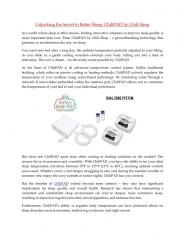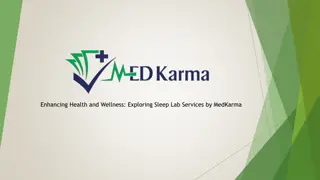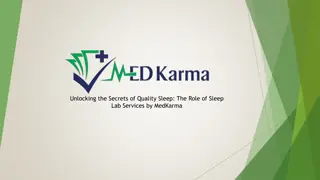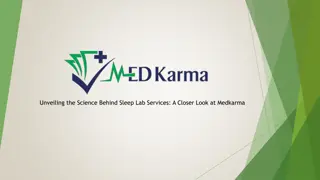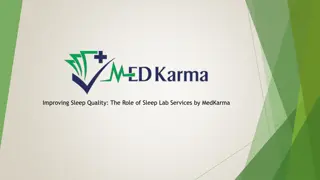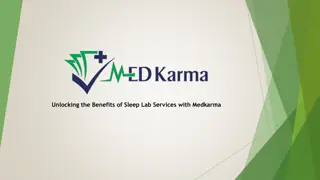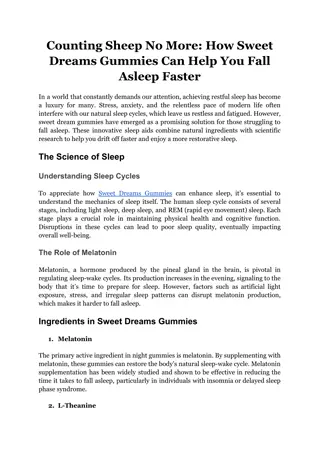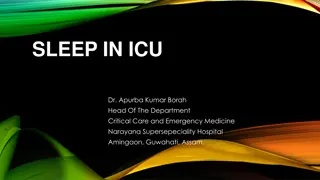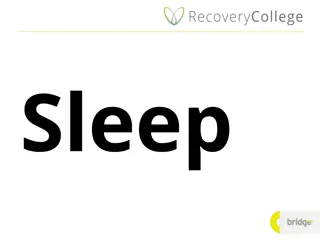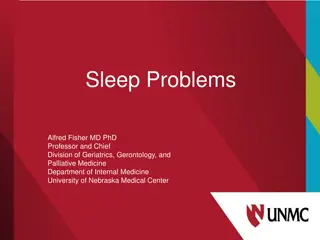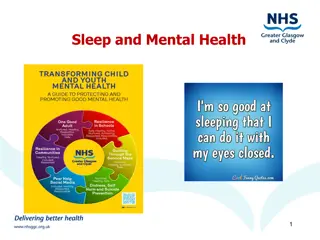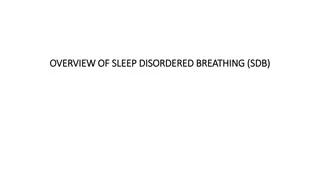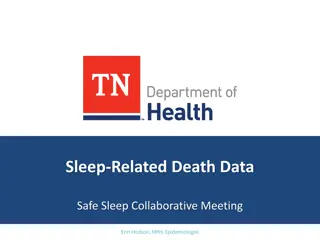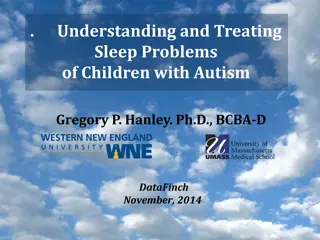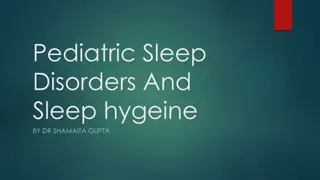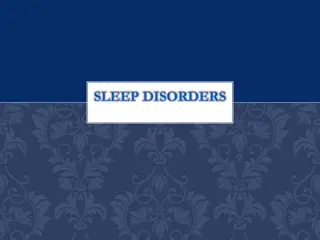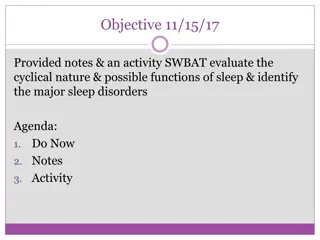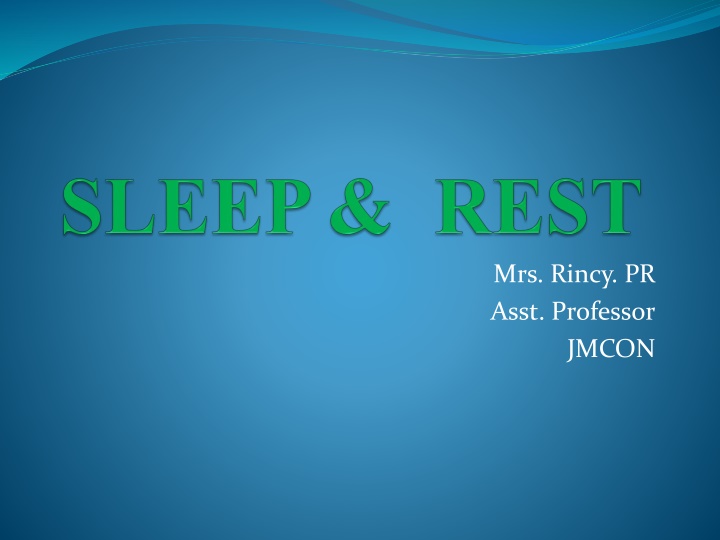
Sleep: Physiology, Stages, Functions, Disorders, and Interventions
Explore the definition of sleep and rest, delve into the physiology of sleep including circadian rhythms and brain control, discover the stages of sleep, roles of Melatonin and Cortisol, factors affecting sleep, common sleep disorders, and nursing interventions for promoting quality sleep.
Download Presentation

Please find below an Image/Link to download the presentation.
The content on the website is provided AS IS for your information and personal use only. It may not be sold, licensed, or shared on other websites without obtaining consent from the author. If you encounter any issues during the download, it is possible that the publisher has removed the file from their server.
You are allowed to download the files provided on this website for personal or commercial use, subject to the condition that they are used lawfully. All files are the property of their respective owners.
The content on the website is provided AS IS for your information and personal use only. It may not be sold, licensed, or shared on other websites without obtaining consent from the author.
E N D
Presentation Transcript
Mrs. Rincy. PR Asst. Professor JMCON
SPECIFIC OBJECTIVES Define sleep and rest Mention the physiology of sleep Describe the stages of sleep Draw the sleep cycle Enumerate the functions of sleep Explain the factors affecting sleep Describe the sleep disorders Write the nursing interventions for promoting sleep
Definition Rest is a condition in which the body is in a decreased state of activity without physical emotional stress and freedom from anxiety. Sleep is a state of rest accompanied by altered level of consciousness and relative inactivity, and perception to environment are decreased
PHYSIOLOGY OF SLEEP The cyclic nature of sleep is thought to be controlled by Centers located in the brain and by Circadian Rhythms. Reticular activating system (RAS) located at the brain stem and Cerebral Cortex plays an important role in sleep wake cycle.
.PHYSIOLOGY OF SLEEP Sleep begins with the activation of the pre optic area of the anterior hypothalamus. Sleep promoting neurons act over wake promoting neurons by releasing Gamma Amino Butyric Acid (GABA). The inhibition of wake promoting neurons results in intensifying sleep process.
.PHYSIOLOGY OF SLEEP Another key factor to sleep is exposure to darkness. Darkness and preparing for sleep (e.g., lying down, decreasing noise) cause a decrease in stimulation of the RAS. During this time, the Pineal gland in the brain begins to actively secrete the natural hormone Melatonin, and the person feels less alert.
.PHYSIOLOGY OF SLEEP With the beginning of daylight, Melatonin is at its lowest level in the body and the stimulating hormone, Cortisol , is at its highest causing wakefulness.
Circadian Rhythms It is a sort of 24-hour internal biological clock. The term circadian is from the Latin circa dies ,meaning about a day. Biological rhythms exist in plants, animals, and humans. In humans, these are controlled from within the body and environmental factors, such as light and darkness. synchronized with
Types/ Stages/ Phases Of Sleep Electroencephalogram (EEG) patterns, eye movements and muscle activity are used to identify stages of sleep. The stages of sleep are classified into two stages: Non Rapid Eye Movement (NREM)Sleep o Stage1 o Stage2 o Stage3 o Stage4 Rapid Eye Movement Stage(rem)Sleep. During sleep, NREM and REM sleep alternate incycles
Non Rapid Eye Movement (NREM) Sleep First stage of sleep is known as NREM sleep. About 75% to 80% of sleep during a night is NREM sleep. It consists of four stages: o Stage1 o Stage2 o Stage3 o Stage4
NREM Sleep Stage 1: NREM Stage lasts a few minutes. It includes lightest level of sleep. Gradual fall in vital signs and metabolism. General slowing of EEG frequency Eyes tend to roll slowly from side to side Sensory stimuli such as noise easily arouses person. Sleeper may deny he is sleeping.
NREM Sleep Stage 2: NREM Stage lasts 10 to 20 minutes. It is a period of sound sleep. Relaxation progresses. Further slowing of EEG Absent eye ball movements Body functions continue to slow. Arousal remains relatively easy
NREM Sleep Stage 3: NREM Stage lasts 15 to 30 minutes. It involves initial stages of deep sleep. Muscles are completely relaxed. Large slow waves in EEG Vital signs decline but remain regular. Sleeper is difficult to arouse and rarely moves
NREM Sleep Stage 4: NREM Stage lasts approximately 15 to 30 minutes. It is the deepest stage of sleep. If sleep loss has occurred, sleeper spends considerable portion of night in this stage. Vital signs are significantly lower than during waking hours. Further slowing of EEG Sleepwalking and enuresis sometimes occur. It is very difficult to arouse sleeper (bed-wetting)
REM Sleep Stage usually begins about 90 minutes after sleep has begun. Dreaming occurs in this stage Stage is typified by rapidly moving eyes, fluctuating heart and increased or fluctuating blood pressure, loss of skeletal muscle tone, and increase of gastric secretions. EEG pattern resembles that of awake state. It is very difficult to arouse sleeper. respiratory rates,
FUNCTIONS OF SLEEP Conservation of energy Restoration of tissues and growth Thermoregulation Regulation of emotions- sleep deprivation causes emotional disorders like irritability, anxiety, depression etc. Neural maturation Memory and learning- there will be information transfer between cerebral cortex and hippocampus during sleep
Normal Sleep Requirements Newborn: 16-18 hours /day Infants: 12-14 hours Toddlers: 10-12 hours Preschool: 11-12 hours School-Age: 8- 12 hours Adolescents: 8-10 hours Adult: 6-8 hours Elders: 6 hours
FACTORS AFFECTING SLEEP Both the quality and the quantity of sleep are affected by a number of factors. Sleep quality is a subjectivecharacteristic Quantity of sleep is the total time the individual sleeps. 1. AGE 2. Illness Illness that causes pain or physical distress (e.g., arthritis, backpain) can result in sleep problems
.FACTORS AFFECTING SLEEP Examples: Respiratory conditions Pain need to urinate during the night
.FACTORS AFFECTING SLEEP 3. Environment Environment can promote or hinder sleep Any change for example, noise in the environment caninhibit sleep. The absence of usual stimuli or the presence of unfamiliar stimuli can prevent people from sleeping Discomfort from environmental temperature (e.g., too hot or cold) and lack of ventilation can affect sleep
.FACTORS AFFECTING SLEEP Light levels can be another factor Another influence includes the comfort and size of the bed. A person s partner who has different sleep habits, snores, or has other sleep difficulties may become a problem for the person also.
.FACTORS AFFECTING SLEEP 4. Lifestyle Following an irregular morning and night time schedule can affect sleep. Night shift workers frequently obtain less sleep than other workers and have difficulty falling asleep.
.FACTORS AFFECTING SLEEP 5. Emotional Stress Stress is considered to be the major cause of short-term sleeping difficulties . A person preoccupied with personal problems (e.g., school- or job-related pressures, family or marriage problems) may be unable to relax sufficiently to get to sleep.
.FACTORS AFFECTING SLEEP 6. Stimulants and Alcohol Caffeine-containing stimulants of the central nervous system (CNS). Drinking beverages containing Caffeine in the afternoon or evening may interfere with sleep. Even though alcohol induces sleep, it disturbs REM sleep causing irritability. beverages act as
.FACTORS AFFECTING SLEEP 7. Diet Certain foods induces sleep Ex: the L- tryptophan present in the milk induces sleep
8. Smoking Nicotine has a stimulating effect on the body, and smokers often have more difficulty falling asleep than non smokers. Smokers can be easily aroused
.FACTORS AFFECTING SLEEP 9. Motivation Motivation can increase alertness in some situations Ex: During the time of examination Browsing internet in the late night
.FACTORS AFFECTING SLEEP 10. Medications: Beta-blockers have been known to cause insomnia. Narcotics, such as morphine, are known to suppress REM sleep and to cause frequent awakenings and drowsiness. Most Hypnotics suppresses REM sleep
SLEEP DISORDERS Sleep disorders are mainly classified into 3 categories SLEEP DISORDERS DISORDERSDUE TO OTHER MEDICAL CONDITIONS DYSOMNIAS PARASOMNIAS
DYSOMNIAS The sleep itself is pretty normal. But the client sleeps too little, too much, or at the wrong time. So, the problem is with the amount (quantity), or with its timing, and sometimes with the quality of sleep.
DYSOMNIAS Common Dysomnias are: Insomnia Hypersomnia Narcolepsy Sleep Apnea Insufficient Sleep/ Sleep Deprivation
Insomnia Insomnia is described as the inability to fall asleep or remain asleep. Persons with insomnia awaken not feeling rested. Insomnia is the most common sleep complaint. Acute insomnia lasts one to several nights and is often caused by personal stressors or worry. If the insomnia persists for longer than a month, it is considered Chronic insomnia
..Insomnia Insomnia can result from physicl discomfort and more often from mental tension or anxiety. People who are habituated to drugs or who takes large amounts of alcohol are at high risk for insomnia.
Insomnia Clinicalmanifestations: Difficulty falling asleep Waking up frequently during the night Difficulty returning to sleep Waking up too early in the morning Unrefreshing sleep Daytime sleepiness Difficulty concentrating Irritability
Insomnia Treatment is development of new behavioral patterns that induces sleep Create a sleeping environment that induces sleep Create positive sleep thoughts
Hypersomnia Hypersomnia refers to conditions where the affected individual obtains sufficient sleep at night but still cannot stay awake during the day. Hypersomnia can be conditions, for example, CNS damage and certain kidney, liver, or metabolic disorders, such as diabetic acidosis and hypothyroidism. caused by medical
Hypersomnia Treatment of hypersomnias include treating the underlying disease conditions
Narcolepsy Narcolepsy is a disorder of excessive daytime sleepiness caused by the lack of the chemical hypocretin in the area of the CNS that regulates sleep. Clients with narcolepsy have sleep attacks or excessive daytime sleepiness, and their sleep at night usually begins with a sleep-onset REM period (dreaming sleep occurs within the first 15 minutes of falling asleep).
Narcolepsy People sleeps several times a day even when they are conversing with people or while driving. CNS stimulants and Antidepressants are the drugs used to treat narcolepsy.
Sleep Apnea Sleep Apnea is characterized by frequent short breathing pauses during sleep. Although all individuals have occasional periods of apnea during sleep, more than five apneic episodes longer than 10 seconds in an hour is considered abnormal and should be evaluated by a sleep medicine specialist.
.Sleep Apnea Sleep Apnea is most frequently diagnosed in men and postmenopausal women, it may occur during childhood. Three types of apnoea based on the cause 1. Obstructive Apnoea 2. Central Apnea 3. Mixed Apnea
.Sleep Apnea 1. OBSTRUCTIVE APNOEA: Obstructive apnea occurs when the structures of the pharynx or oral cavity block the flow of air. Enlarged tonsils and adenoids, a deviated nasal septum, nasal polyps, and obesity predispose the client to obstructive apnea Treatment includes surgical removal of tonsills, correcting nasal septum, weight loss may be helpful.
.Sleep Apnea 2. CENTRAL APNEA: Due to defect in the respiratory centre of the brain. Clients who have brainstem injuries and often have central sleep apnea. 3.MIXED APNOEA Mixed apnoea is combination of obstructive and central apnea
Insufficient Sleep/ Sleep Deprivation A prolonged disturbance in quality and quantity of sleep can lead to a syndrome called as sleep deprivation. It is not a sleep disorder but result of prolonged sleep disturbance. It produces various physiological and behavioural symptoms based on the severity of deprivation.
Insufficient Sleep/ Sleep Deprivation Individuals may develop: Attention and concentration deficits Reduced vigilance Distractibility Reduced motivation Fatigue Diplopia and dry mouth.
PARASOMNIAS Something abnormal occurs during sleep itself, or during the times when the client is falling asleep or waking up The quality, quantity, and timing of the sleep are essentially normal. Most common DISORDERS are: Bruxism Enuresis Periodic limb movement disorder Sleep talking Sleep walking
.PARASOMNIAS Bruxism. Usually occurring during stage II NREM sleep, characterized by clenching and grinding of the teeth. Enuresis. Bed-wetting during sleep occuring in children over 3 years old. More males than females are affected. It often occurs 1 to 2 hours after falling asleep.
.PARASOMNIAS Periodic limb movement disorder (PLMD). In this condition, the legs jerk twice or three times per minute during sleep. It is most common among older adults. Respond well to medications such as levodopa, pramipexole , ropinirole, and gabapentin

